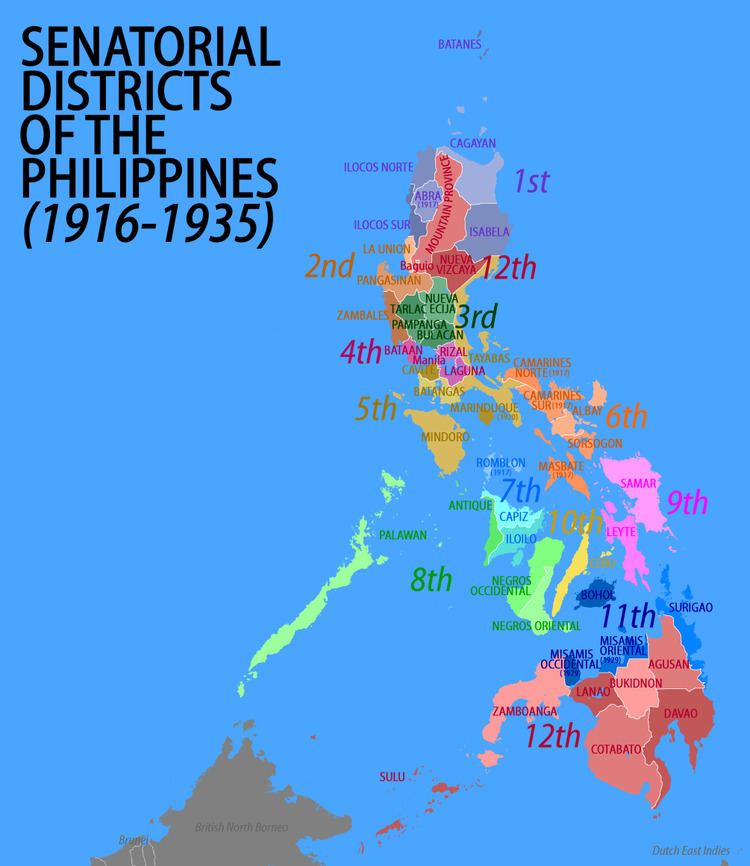 | ||
The Senatorial districts of the Philippines were the representations of the provinces of the Philippines in the Philippine Senate from 1916 to 1935.
Contents
History
The enactment of the Philippine Autonomy Act (popularly known as "Jones Law") in August 1916 by the United States Congress provided for the creation of a bicameral legislature consisting of a lower chamber (House of Representatives) and an upper chamber (Senate). Until then the Philippine Commission held the executive power and some legislative powers over the American colony.
The system of government of the Philippines in its early years of transition to democratic self-government was deliberately structured to emulate the American model. The Philippines thus followed the American system of electing the members of the 24-seat senate by district.
The districts were organized and numbered in a roughly north-south fashion, much like the present administrative regions. The first eleven districts were composed of established provinces, while the twelfth was composed of the provinces of the Luzon interior and much of Mindanao — both of which were never fully administered by the old Spanish colonial government and designated by American authorities as "Non-Christian" areas.
The first to eleventh districts elected two senators each by popular vote. The two senators from the twelfth district were appointed by the U.S. Governor-General. The setup lasted until the establishment of the Commonwealth of the Philippines in 1935, when the bicameral legislature was abolished, as the 1935 Constitution provided only for a unicameral National Assembly. However, when the Constitution was amended in 1940 to re-establish a bicameral Congress, members of the Senate had to be voted at-large, thereby effectively abolishing the district system.
First District
Provinces: Batanes, Cagayan, Ilocos Norte, Ilocos Sur, Isabela
Later additional provinces: Abra (separated from Ilocos Sur, 1917)
Second District
Provinces: La Union, Pangasinan, Zambales
Third District
Provinces: Bulacan, Nueva Ecija, Pampanga, Tarlac
Fourth District
City: Manila
Provinces: Bataan, Laguna, Rizal
Fifth District
Provinces: Batangas, Cavite, Mindoro, Tayabas
Later additional provinces: Marinduque (from Tayabas, 1920)
Sixth District
Provinces: Albay, Ambos Camarines, Sorsogon
Later additional provinces: Camarines Norte and Camarines Sur (resulted from the division of Ambos Camarines, 1917), Masbate (separated from Sorsogon, 1917)
Seventh District
Provinces: Capiz, Iloilo
Later additional provinces: Romblon (separated from Capiz, 1917)
Eighth District
Provinces: Antique, Negros Occidental, Negros Oriental, Palawan
Ninth District
Tenth District
Provinces: Cebu
Eleventh District
Provinces: Bohol, Misamis, Surigao
Later additional provinces: Misamis Occidental and Misamis Oriental (resulted from the division of Misamis province, formally divided in 1929 but only implemented in 1939)
Twelfth District
City: Baguio City
Provinces: Department of Mindanao and Sulu (consisted of Agusan, Bukidnon, Cotabato, Davao, Lanao, Sulu and Zamboanga provinces), Mountain Province (consisted of Apayao, Benguet, Bontoc, Ifugao, and Kalinga subprovinces; the original subprovinces of Amburayan and Lepanto ceased to exist after reorganization), Nueva Vizcaya
